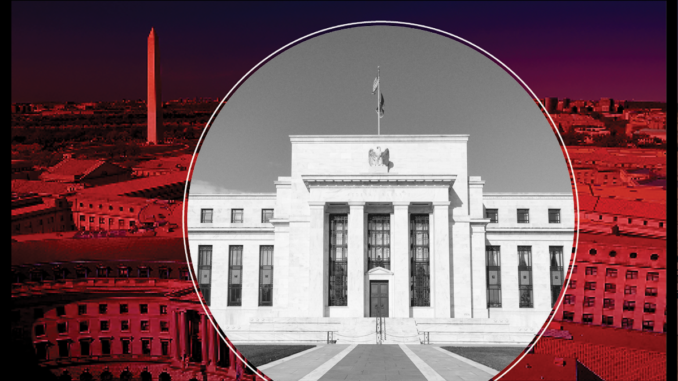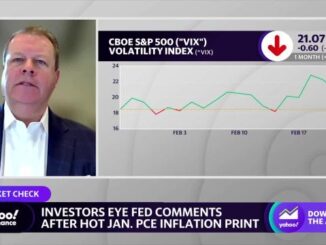
The Federal Reserve (Fed) has decided to forge ahead in its fight against inflation, despite several bank closures that have caused turbulence in the financial markets. On Wednesday, the Federal Open Market Committee (FOMC) announced the decision to raise the federal funds rate by 25 basis points to 4.75%-5%, its ninth consecutive rate hike.
“The U.S. banking system is sound and resilient. Recent developments are likely to result in tighter credit conditions for households and businesses and to weigh on economic activity, hiring, and inflation. The extent of these effects is uncertain. The Committee remains highly attentive to inflation risks,” the FOMC said in a statement.
Expectations that the Fed would increase rates by 25 basis points – or pause its monetary tightening – grew in recent weeks following the Silvergate Bank, Silicon Valley Bank and Signature Bank failures, the rescue of First Republic Bank, and the acquisition of Credit Suisse by its competitor UBS. A number of financial institutions in the U.S. are suffering from a lack of liquidity amid deposit runs.
Fed Chairman Jerome Powell told reporters on Wednesday that since the previous FOMC meeting in February, economic indicators have generally come in stronger than expected. “We believe, however, that events in the banking system over the last two weeks will result in tighter credit conditions for small businesses, which will affect economic outcomes,” he said, adding that it’s too soon to determine how monetary policy should respond to the banks collapses.
As a result, the FOMC no longer states that “ongoing rate increases will be appropriate” to combat inflation. “Instead, we now anticipate that some additional policy firming may be appropriate,” Powell said.
The latest – perhaps final – rate increase comes on the heels of eight rate hikes since March 17, 2022, which includes four 75 basis point increases in June, July, September and November, a 50 basis point increase in December and 25 basis point hike in February.
Before the banks broke, monetary policy observers had previously forecasted a 50 basis point increase for the March meeting, as recent inflation data came in three times higher than the target.
The Fed, of course, based its decision to hike 25 bps largely on the cooling – but still present – inflation data. In February, the Consumer Price Index (CPI) rose by 6% before seasonal adjustment compared to one year ago, lower than the 6.4% increase recorded in the 12 months ending in January. The CPI increased 0.4% on a monthly basis in February after rising 0.5% in January.
In economic projections released Wednesday, the Fed expects interest rates will be at 4.3% at the end of 2024, up from 4.1% previously. The Fed also revised its forecast on inflation, which it expects to be slightly higher than its December estimate. It also offered a slightly lower forecast for unemployment this year, which suggests a longer and more muted approach to tamping down inflation. The projected inflation rate for the year is now 3.3%, up from 3.1% in December while economic growth in 2023 is now forecast to be 0.4%, down from 0.5% in December.
A contingent of financial analysts believe that a further increase in rates would be counterproductive to manage the current market turbulence for banks. The assets banks have in their portfolios and need to sell to pay for their customers’ withdrawals usually have a price reduction when interest rates rise. Ultimately, the Fed can escalate the crisis by increasing the federal funds rate, these analysts said.
In addition, the stress on smaller banks may result in tightening lending standards, requiring fewer rate hikes from the Fed to cool down the economy and combat high inflation. Analysts at Goldman Sachs estimate that the current turbulence could bring an incremental U.S. economy growth drag of 25 to 50 basis points in 2023.
“Our rule of thumb implies that this incremental tightening in lending standards would have the same impact on growth that roughly 25-50 basis points of rate hikes would have via their impact on market-based financial conditions,” Goldman Sachs analysts wrote.
Powell, however, said the weaknesses at SVB are not broadly present in the banking system. The bank’s management “failed badly,” and the financial institution was an “outlier” in terms of the percentage of uninsured deposits and its holdings on duration risk, Powell said. The Fed Chairman also added that he does not see the same problem with regional banks concentrated on commercial real estate.
“The Fed believes work remains to be done,” according to Michele Raneri, vice president and head of U.S. research and consulting at TransUnion. “From a consumer credit perspective, the impact of further rate hikes will likely continue to be felt by borrowers, particularly in industries such as mortgage and credit cards,” Raneri said in a statement.
Impact on the housing market
In the housing market, the bank collapses over the last few weeks have sent mortgage rates downward, though they remain volatile.
Investors looking for a safe harbor have bought treasury bonds, reducing their yields. Mortgage rates are historically correlated to the 10-year Treasury, which has dropped by more than 40 basis points since the beginning of March.
At the HousingWire Mortgage Rates Center, the Optimal Blue data shows rates at 6.53% on Tuesday, up from 6.42% on Friday. Meanwhile, Mortgage News Daily showed the 30-year fixed conventional mortgage rate at 6.70% on Wednesday afternoon, down from 7.10% at the beginning of March but up eight basis points from Monday.
A growing number of market observers say this 25 bps increase might end up being the last rate hike.
“This was a ‘dovish hike,’ as the commentary and economic projections suggest we may be at or near the peak fed funds rate for this cycle,” said Mike Fratantoni, the Mortgage Bankers Association‘s chief economist. “Homebuyers in 2023 have shown themselves to be quite sensitive to any changes in mortgage rates. With this move from the Federal Reserve, MBA is holding to its forecast that mortgage rates are likely to trend down over the course of this year, which should provide support for the purchase market. The housing market was the first sector to slow as the result of tighter monetary policy and should be the first to benefit as policymakers slow – and ultimately stop – hiking rates.”
Fratantoni said the Fed looks poised to continue quantitative tightening, allowing Treasury and Agency MBS to passively roll off the Fed’s balance sheet.
“We expect that the recent increase in direct lending by the Fed through the discount window and the new term lending facility will help to improve liquidity for banks, despite this ongoing reduction in the size of the Fed’s securities holdings,” he said.
Looking forward, analysts at Jefferies believe uncertainty remains for the mortgage industry. “With increasing volatility, we have seen short-term rates come down, and while mortgage rates have come down, it has not been to the same extent as shorter-duration assets,” the analysts wrote in a report this week.
“At the same time, we acknowledge incremental volatility as a further headwind to the potential recovery for purchase, as both buyers and sellers remain on the sidelines,” the analysts added.
Regarding the housing market, Powell said that “activity remains weak largely reflecting higher mortgage rates.” The Fed Chairman also sees inflation cooling down in the housing services. “We continue to see the new leases being signed at much lower levels of inflation.”



